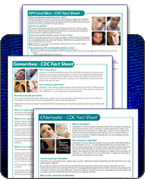Chlamydia - CDC Fact Sheet


What is chlamydia?
Chlamydia is a common sexually transmitted disease (STD) caused by a bacterium. Chlamydia can infect both men and women and can cause serious, permanent damage to a woman's reproductive organs.
How common is chlamydia?
Chlamydia is the most frequently reported bacterial sexually transmitted infection in the United States. In 2011, 1,412,791 cases of chlamydia were reported to CDC from 50 states and the District of Columbia, but an estimated 2.8 million infections occur annually. A large number of cases are not reported because most people with chlamydia do not have symptoms and do not seek testing. Chlamydia is most common among young people. It is estimated that 1 in 15 sexually active females aged 14-19 years has chlamydia.
How do people get chlamydia?
People get chlamydia by having sex with someone who has the infection. “Having sex” means anal, vaginal, or oral sex. Chlamydia can still be transmitted even if a man does not ejaculate. People who have had chlamydia and have been treated can get infected again if they have sex with an infected person.
Chlamydia can also be spread from an infected woman to her baby during childbirth.
Who is at risk for chlamydia?
Any sexually active person can be infected with chlamydia. It is a very common STD, especially among young people. It is estimated that 1 in 15 sexually active females aged 14-19 years has chlamydia.
Sexually active young people are at high risk of acquiring chlamydia for a combination of behavioral and biological reasons. Men who have sex with men (MSM) are also at risk for chlamydial infection since chlamydia can be transmitted by oral or anal sex.
What are the symptoms of chlamydia?

Chlamydia is known as a ‘silent’ infection because most infected people have no symptoms. If symptoms do occur, they may not appear until several weeks after exposure. Even when it causes no symptoms, chlamydia can damage a woman’s reproductive organs.
In women, the bacteria first infect the cervix (structure that connects the vagina or birth canal to the uterus or womb) and/or the urethra (urine canal). Some infected women have an abnormal vaginal discharge or a burning sensation when urinating. Untreated infections can spread upward to the uterus and fallopian tubes (tubes that carry fertilized eggs from the ovaries to the uterus), causing pelvic inflammatory disease (PID). PID can be silent, or can cause symptoms such as abdominal and pelvic pain. Even if PID causes no symptoms initially, it can lead to infertility (not being able to get pregnant) and other complications later on.
Some infected men have discharge from their penis or a burning sensation when urinating. Pain and swelling in one or both testicles (known as “epididymitis”) may also occur, but is less common.
Chlamydia can also infect the rectum in men and women, either through receptive anal sex, or possibly via spread from the cervix and vagina. While these infections often cause no symptoms, they can cause rectal pain, discharge, and/or bleeding (known as “proctitis”).
What complications can result from chlamydial infection?
The initial damage that chlamydia causes often goes unnoticed. However, chlamydial infections can lead to serious health problems.
In women, untreated infection can spread upward to the uterus and fallopian tubes (tubes that carry fertilized eggs from the ovaries to the uterus), causing pelvic inflammatory disease (PID). PID can be silent, or can cause symptoms such as abdominal and pelvic pain. Both symptomatic and silent PID can cause permanent damage to a woman’s reproductive tract and lead to long-term pelvic pain, inability to get pregnant, and potentially deadly ectopic pregnancy (pregnancy outside the uterus).
In pregnant women, untreated chlamydia has been associated with pre-term delivery, and can spread to the newborn, causing an eye infection or pneumonia.
Complications are rare in men. Infection sometimes spreads to the tube that carries sperm from the testis, causing pain, fever, and, rarely, preventing a man from being able to father children.
What about chlamydia and HIV?
Untreated chlamydia may increase a person’s chances of acquiring or transmitting HIV – the virus that causes AIDS.
How does chlamydia affect a pregnant woman and her baby?
In pregnant women, untreated chlamydia has been associated with pre-term delivery, and can spread to the newborn, causing an eye infection or pneumonia. Screening and treatment of chlamydia during pregnancy is the best way to prevent these complications. All pregnant women should be screened for chlamydia at their first prenatal visit.
Who should be tested for chlamydia?
Any sexually active person can be infected with chlamydia. Anyone with genital symptoms such as discharge, burning during urination, unusual sores, or rash should avoid having sex until they are able to see a health care provider about their symptoms.
Also, anyone with an oral, anal, or vaginal sex partner who has been recently diagnosed with an STD should see a health care provider for evaluation.

Find an STD testing site near you.
CDC recommends yearly chlamydia testing for all sexually active women age 25 or younger and older women with risk factors for chlamydial infections (e.g., women who have a new or more than one sex partner), and all pregnant women. Any woman who is sexually active should discuss her risk factors with a health care provider who can then determine if more frequent testing is necessary.
Men who have sex with men (MSM) who have receptive anal sex should be tested for chlamydia each year. MSM who have multiple and/or anonymous sex partners should be tested more frequently.
HIV-infected sexually active women who are age 25 or younger or have other risk factors, and all HIV-infected patients who report having receptive anal sex should be tested for chlamydia at their first HIV care visit and then at least annually. A patient’s health care provider might determine more frequent testing is necessary, based on the patient’s risk factors.
How is chlamydia diagnosed?
There are laboratory tests to diagnose chlamydia. Specimens commonly used for testing include a cotton swab of the vagina (collected by the woman herself or her health care provider) or a urine sample.
What is the treatment for chlamydia?
Chlamydia can be easily treated and cured with antibiotics. HIV-positive persons with chlamydia should receive the same treatment as those who are HIV-negative.
Persons with chlamydia should abstain from having sex for seven days after single dose antibiotics, or until completion of a seven-day course of antibiotics, to prevent spreading the infection to partners.
Repeat infection with chlamydia is common. Persons whose sex partners have not been appropriately treated are at high risk for re-infection. Having multiple chlamydial infections increases a woman's risk of serious reproductive health complications, including pelvic inflammatory disease and ectopic pregnancy. Women and men with chlamydia should be retested about three months after treatment of an initial infection, regardless of whether they believe that their sex partners were successfully treated.
Infants infected with chlamydia may develop conjunctivitis (infection of the membrane lining the eyelids) and/or pneumonia. Chlamydial infection in infants can be treated with antibiotics.
What about partners?
If a person has been diagnosed and treated for chlamydia, he or she should tell all anal, vaginal, or oral sex partners from the past 2 months so that they can see a healthcare provider and be treated. This will reduce the risk that the sex partners will develop serious complications from chlamydia and will also reduce the person’s risk of becoming re-infected. A person with chlamydia and all of his or her sex partners must avoid having sex until they have completed their treatment for chlamydia (i.e., seven days after a single dose of antibiotics or until completion of a seven-day course of antibiotics) and until they no longer have symptoms. For tips on talking to partners about sex and STD testing, visit www.gytnow.org/talking-to-your-partner/
To help get partners treated quickly, healthcare providers may give patients extra medicine or prescriptions to give to their sex partners. This is called expedited partner therapy or EPT. EPT is only available in some parts of the country. Consult a healthcare provider to find out if it is available in a specific area. Sex partners should still be encouraged to see a healthcare provider, regardless of whether they receive EPT.
How can chlamydia be prevented?
Latex male condoms, when used consistently and correctly, can reduce the risk of getting or giving chlamydia. The surest way to avoid chlamydia is to abstain from vaginal, anal, and oral sex or to be in a long-term mutually monogamous relationship with a partner who has been tested and is known to be uninfected.
Where can I get more information?
Division of STD Prevention (DSTDP)
Centers for Disease Control and Prevention
www.cdc.gov/std
CDC-INFO Contact Center
1-800-CDC-INFO (1-800-232-4636)
Email: cdcinfo@cdc.gov
CDC National Prevention
Information Network (NPIN)
P.O. Box 6003
Rockville, MD 20849-6003
1-800-458-5231
1-888-282-7681 Fax
1-800-243-7012 TTY
E-mail: info@cdcnpin.org
American Social Health Association (ASHA)
P.O. Box 13827
Research Triangle Park, NC 27709-3827
1-800-783-9877
Download page:
View page in

Find an STD testing site near you.
Contact Us:
- Centers for Disease Control and Prevention
1600 Clifton Rd
Atlanta, GA 30333 - 800-CDC-INFO
(800-232-4636)
TTY: (888) 232-6348 - Contact CDC-INFO





